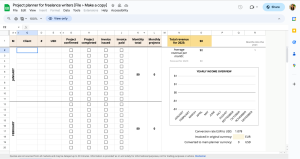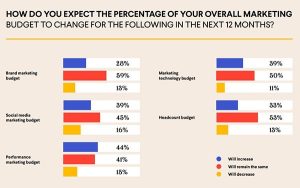In early 2022, business was booming for digital publisher Alpha Brand Media, and staff were struggling to keep up with demand.
“We were going through classic growing pains, needing to scale the company’s infrastructure and workflows and processes and policies, and it was quite disruptive,” recalls CEO Jenise Uehara. “It was chaos, honestly, and we started to lose people—people who had been with us for a long time—and that hurt.”
The fully remote company of 34 was hiring as fast as it could, but finding staff was a challenge, and there was little time and energy left to onboard and train them. Instead, Uehara adopted a solution that she admits sounded counterintuitive at first. Last summer, Alpha Brand Media implemented summer Fridays, giving staff an extra day off every other week, and in October began operating on a four-day, 32-hour schedule.
“When I started to look at it a bit closer, I realized it was really an operational excellence initiative in disguise that provides motivation for your people—a carrot—to make the changes to the processes that they know are inefficient,” she says.
Preparation Is Key
Before making changes to the schedule, Uehara engaged her staff in a ruthless waste-cutting, productivity-enhancing campaign. During that period individual staff members—with support from a multidisciplinary task force of non-leadership employees—found both obvious and novel ways to improve efficiency, from cutting down on meetings to reducing approval layers.
“Every meeting needs to have an agenda, every person needs to have a role, and it has to be okay for people to say, ‘Let’s make this shorter,’ or ‘I don’t need to be here,’” she says. “It becomes an accepted practice, because otherwise nobody wants to tell their boss or a meeting organizer, ‘I don’t think I need to be here.’”
Upon learning that some employees spent significant time catching up on Slack messages and emails in case one required their immediate attention, the team designated WhatsApp as the only platform for emergencies, allowing staff to ignore all other notifications while working.
“If we had expected our people to do five days of work in four, my expectation would be that they would fail, and taking a 20% haircut on our production or revenue was a nonstarter, because the business would fail,” Uehara says. “So how do you get there? You take a look at how and where people are spending their time, and I will wager it’s not always being used most efficiently.”
Six months after launching a four-day workweek trial, Alpha Brand Media—along with every other one of the 41 companies that participated in the same North American pilot program—has decided to make the change permanent. Key to that success, according to Uehara, were the months of planning, research, and consultations that preceded it.
Further Evidence of the Benefits of a Four-Day Workweek
According to 4 Day Week Global, which ran the program, and researchers at Boston College who studied the results, participants enjoyed a range of benefits, from better mental and physical health to lower absenteeism and a 15% average boost in revenue. The findings echoed those of earlier trials conducted in the U.K., Europe, and Australasia, and when researchers checked back in with global participants at the 12-month mark, most of those benefits remained.
“For companies, their revenue increased; their sick days, personal days, and absenteeism were reduced; and their turnover was also reduced,” says Wen Fan, an associate professor at Boston College’s department of sociology, who participated in the research. “The results for employees are similarly exciting, and you see a lot of positive changes.” Wen notes that burnout among employees was reduced, leading to lower stress levels and improvements in physical and mental health, life satisfaction, and job satisfaction.
Fan adds that most of the benefits remained when researchers returned six months after the initial six-month trial period ended.
“Job satisfaction declined when you compare the 6 months to 12 months, but job satisfaction is still considerably higher compared to before the trial,” she says. “Based on the indicators we asked them about, none of these deteriorated to below where they were at the start of the trial, so all of them are still considerably higher than the baseline.”
Incentivizing Staff to Find Productivity Gains
Improving such a broad range of measurements, including productivity and revenue metrics, by reducing work time may seem counterintuitive, but experts suggest the four-day week is effective because it incentivizes staff to participate in productivity-enhancing initiatives.
“It’s not like flipping a light switch; you need to figure out how you’re going to make it work operationally before you introduce the policy,” explains Joe O’Connor, who led that process as the former CEO of 4 Day Week Global, before cofounding the Work Time Reduction Center of Excellence. “That two- to three-month lead-in period involves a number of workshops—we ran about eight or nine—to help companies with time management, productivity, prioritization, measurement, offering them access to resources and key principles and practices to make this work.”
Participants were also assigned mentors from organizations in the same or similar industries who had previously made the transition, as well as other trial participants, to share best practices.
“I would not argue that reducing work time results in this automatic uplift of 15%, 20%, 25% in productivity—it just doesn’t,” O’Connor says. “It requires collectively rethinking structural issues around how you meet, how you collaborate, how you communicate, how you service your clients. This is really about changing the way you work, not just the number of hours you’re working.”
Dale Whelehan, 4 Day Week Global’s current CEO, says that what makes this approach to productivity enhancement more effective than most is one key ingredient: enthusiastic employee participation. He suggests that when employees share in the benefits of efficiency gains, they can find enough to cut hours while still increasing output.
“You essentially tap into what many business and management leaders have been saying for years around Agile ways of working and Lean ways of working, and the need to streamline,” Whelehan says. “We’ve been talking about Six Sigma and all these things for years, but they haven’t been able to effectively apply them, because there’s been a gradual erosion of the relationship between the worker and employer.”
Whelehan adds: “Why would the worker decide to work more effectively if in return they only get more work? This establishes a new contract.”
(5)







